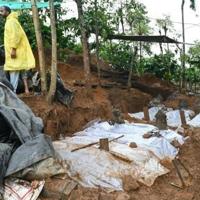Rescue teams in India are searching for survivors in mud-caked tea plantations and villages after devastating landslides claimed the lives of about 200 people.
Heavy monsoon rains have caused widespread damage in the southern state of Kerala, making it difficult for relief efforts to reach the affected areas in the Wayanad district.
The frequency of fatal floods and landslides in India has been on the rise in recent years, with experts attributing the trend to climate change.
Army teams are working tirelessly to build a temporary bridge to facilitate search operations for survivors, after previously resorting to makeshift ziplines to recover bodies.
Saraswathy, a laborer on one of the affected tea estates, expressed little hope of finding her missing family members as the days went by.
Wayanad, known for its picturesque tea estates, has been left devastated by the landslides that swept away homes and families in the middle of the night.
As of Thursday, at least 176 bodies have been recovered from the disaster site, but the final death toll is expected to increase as rescue operations continue.
– ‘High rainfall events’ –
Monsoon rains play a vital role in replenishing water supplies and supporting agriculture in the region, but they also bring widespread destruction and loss of life.
The recent increase in the frequency and intensity of heavy rainfall events has raised concerns among environmental experts about the changing rainfall patterns in the region.
Factors such as damming, deforestation, and development projects have also contributed to the worsening impact of landslides and floods in India.
The country’s worst landslide in recent history occurred in 1998, claiming the lives of over 200 people in the Himalayan village of Malpa.
ash/gle/pbt





